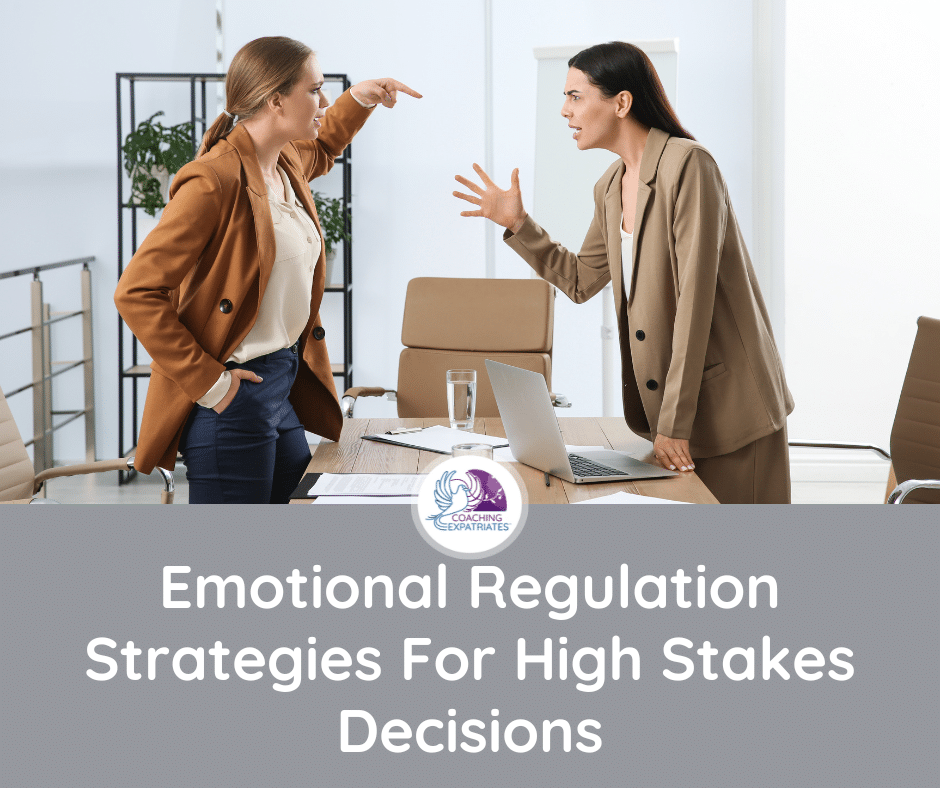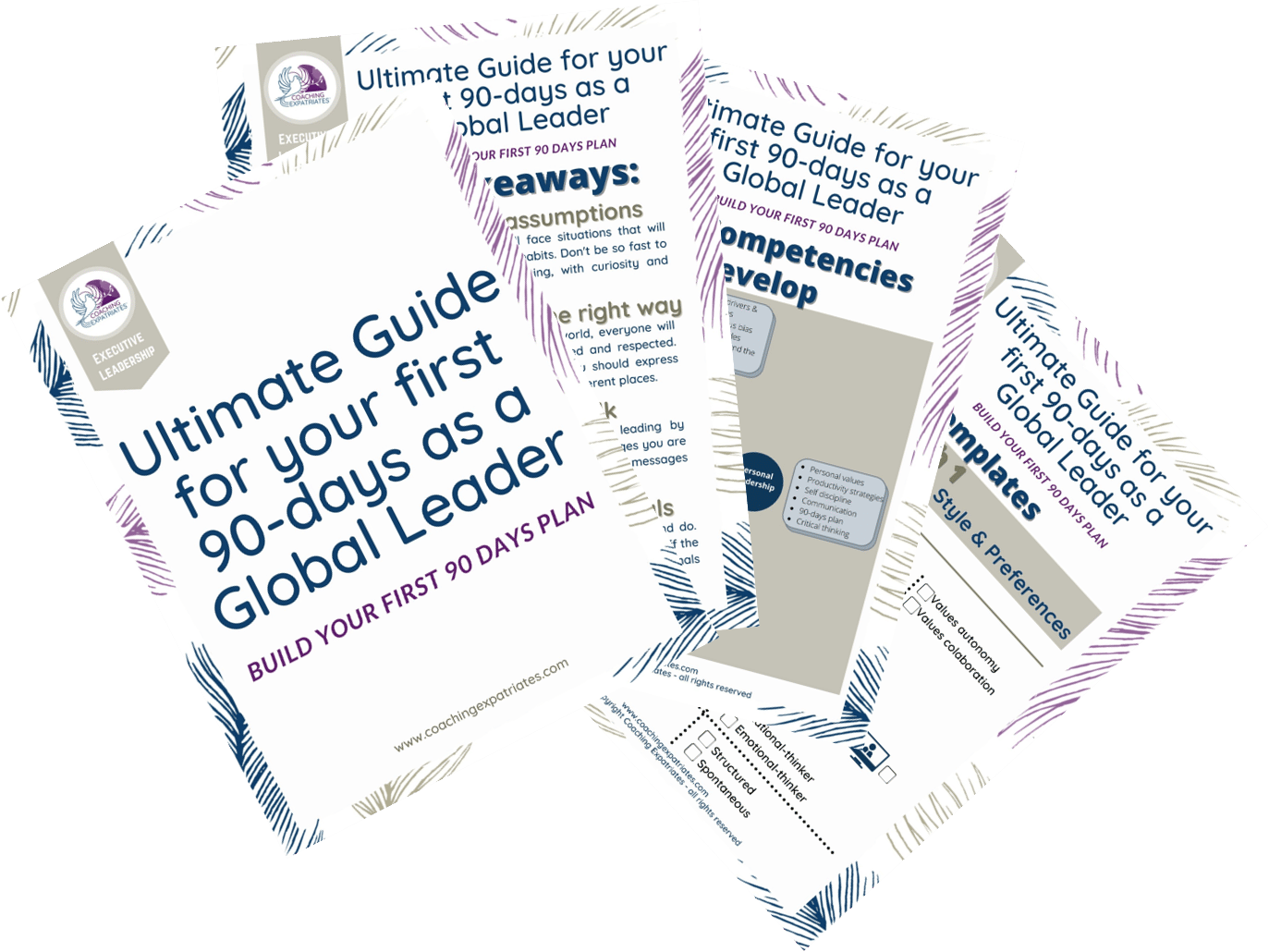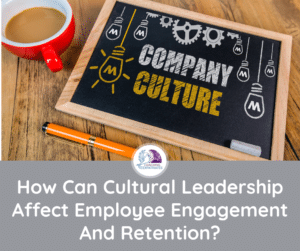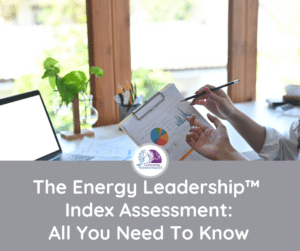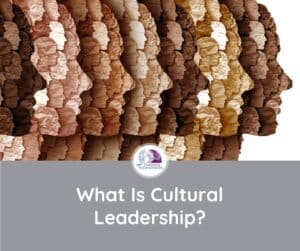Global corporations and their highly qualified executives face today, more than ever, numerous high-stakes decisions that can significantly impact their success. From strategic investments to mergers and acquisitions, these choices require careful consideration and often involve considerable risk. While thorough analysis and strategic planning are crucial, emotional regulation in global leadership is another important aspect that high-achieving global executives shouldn’t overlook. In today’s post, we’ll explore what emotional regulation is, why it plays a pivotal role in making sound decisions in global corporations, and the main strategies to improve emotional regulation for better global leadership performance. And we also got you covered if you want some extra references to get yourself more knowledgeable about the matter.
Understanding Emotional Regulation
Emotional regulation, or emotional self-regulation, refers to the ability to recognize, understand, and effectively manage one’s own emotions and the emotions of others. It is a key component of emotional intelligence, also known as EQ (emotional coefficient), which involves perceiving, understanding, and managing both one’s own emotions and the emotions of others.
When I was around 10 years old, I remember having an emotional outburst; I can’t remember why, and blurting to my brother, “You son of the b**ch!” Both my brother and mom, who were present at the moment, were surprised. He reacted by feeling hurt, while she showed signs of being offended and a bit confused. Although they did not say anything at the moment, their expressions were so evident that I immediately felt a sense of shame and guilt. So much shame that I was not able to immediately apologize. Of course, mind you, I didn’t think lowly of my mother, and it was not my intention to hurt anyone. I’m very grateful that this experience happened in a safe place and with people who deeply loved me and understood me. I learned that a lack of emotional regulation can impact relationships, morale, and even self-talk too. More so, because my mom came to talk to me “about yesterday” and helped me dissect my emotions, what triggered them, put myself in other people’s shoes, and what would be a more helpful way to behave next time. It was the beginning of my journey of learning about emotional regulation, developing skills, and improving my emotional understanding.
Another thing I want to point out is that emotional outbursts are not only prone to kids in the process of learning about self-control. Anyone can be hijacked by their emotions and behave in ways that they regret later. Also, many times people say things they don’t actually mean. And sometimes, they actually mean something very different from what they are saying. Your teenager might say “I hate you” when they actually mean “I’m so frustrated!” or a spouse might blurt a “Fine” when they actually mean, “I feel so unheard!”
Emotional understanding and self-regulation are required to navigate all these different aspects in challenging moments when emotions are triggered. Emotional self-regulation encompasses various psychological aspects and skills contributing to emotional well-being and interpersonal effectiveness. Let’s review what they are.
The Psychological Aspects Of Emotional Regulation:
1. Self-Awareness: Emotional regulation begins with self-awareness, which involves recognizing and understanding one’s own emotions. It includes the ability to identify and label different emotions accurately, understand their triggers, and discern the intensity and duration of emotional responses. Different emotions require different responses and coping strategies, so self-awareness is critical for proper emotional regulation.
2. Self-Control: Self-control is the ability to manage and regulate one’s emotional reactions. It involves modulating impulsive behaviors, delaying gratification, and maintaining composure in challenging situations. Self-control allows individuals to think before acting and make decisions based on thoughtful analysis and established decision criteria rather than fleeting emotions.
3. Emotion Understanding: Emotional regulation requires an understanding of the complex nature of emotions. It involves recognizing the nuances of different emotions, understanding their underlying causes and consequences, and appreciating the interplay between thoughts, feelings, and behaviors. This is especially helpful when dealing with and managing the emotions of other people you lead. Emotional intelligence, or emotional coefficient (EQ), is needed to navigate these complex situations. I love the EQ definition by Justin Bariso, which says, “Emotional intelligence is the ability to make emotions work for you, instead of against you.”
4. Empathy: Empathy is the ability to understand and share the feelings of others. It enables individuals to perceive and respond to the emotions of colleagues, employees, and stakeholders. Empathy facilitates effective communication, fosters positive relationships, and promotes collaboration in decision-making processes.
5. Validation: According to Dr. Cassio Campello de Menezes, MD, MA in Mental Health Counseling and Licensed Associate Counselor, “Validation is an important part of any relationship, including the relationship you have with yourself. Validation is what makes you feel heard and respected. It means to confirm, to verify, to authenticate. Validation can be verbal or nonverbal and helps deepen relationships.” It can also improve rapport and any efforts to build trust. When validating others, said Dr. Cassio, one makes them feel heard and respected, while when validating yourself, you provide that same comfort on your own. It’s also important to note that validation does not mean agreement. It means you are confirming the understanding of a point of view or situation. For example, when you say, “It’s understandable that you are upset,” you are confirming your understanding of how the other person is feeling and why, but it does not mean you are in agreement with them being this way.
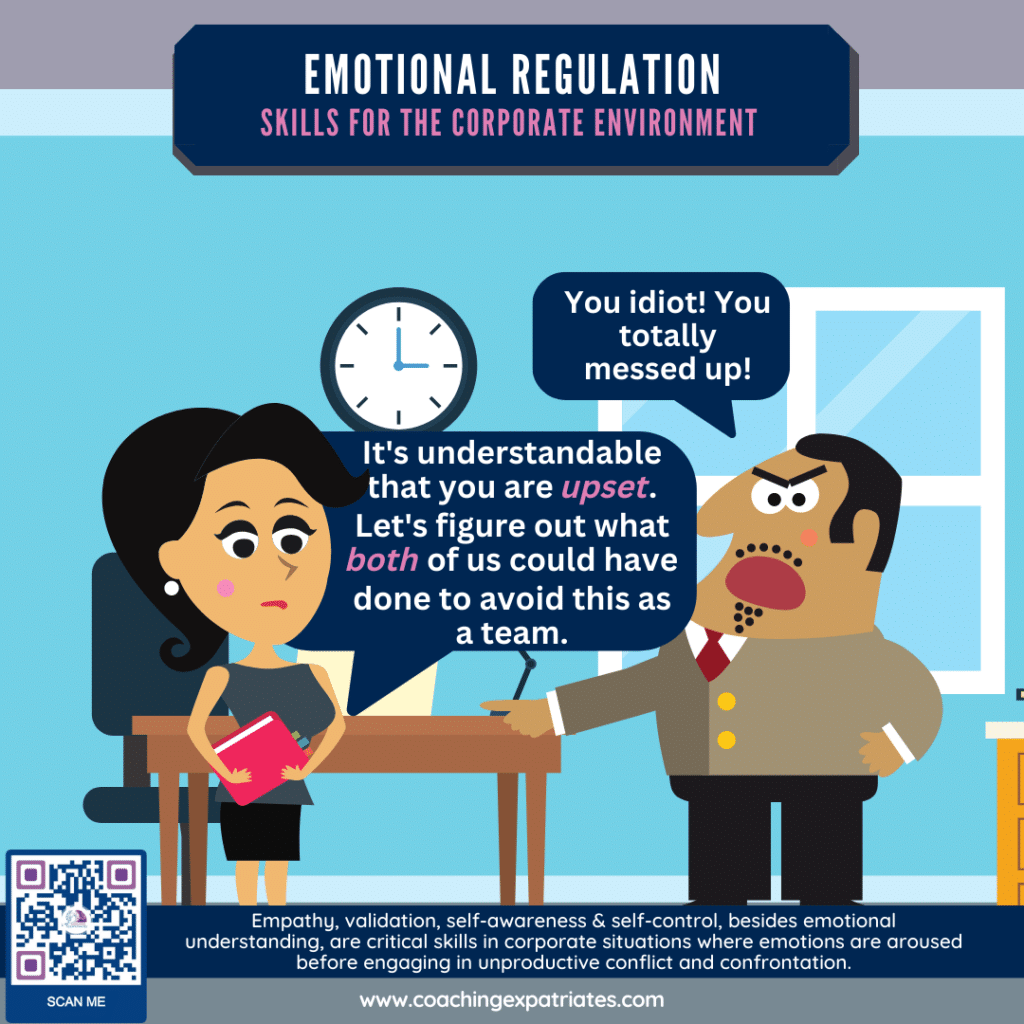
Developing all these psychological aspects is an important factor when embarking on a journey of emotional regulation and self-improvement with global leadership in mind. The global environment has all sorts of people with different cultures and behaviors that might be the perfect backdrop for misunderstandings and miscommunication, which may trigger emotions that could impact behavior and decisions.
A lot of corporate executives think that emotional regulation is only necessary when dealing with their teenage kids or their angry bosses, but they forget that emotions are what permeate all our behaviors and decisions as leaders. And we make decisions on a daily basis, and some of these decisions can have a critical impact when we have a reduced ability for emotional regulation.
Empathy, validation, self-awareness & self-control, besides emotional understanding, are critical skills in corporate situations where emotions are aroused before engaging in unproductive conflict and confrontation.
Importance of Emotional Regulation in High-Stakes Decision-Making
In the high-pressure environments of global corporations, decisions often involve significant financial investments, major organizational and cultural changes, and potential consequences for numerous stakeholders. Emotional regulation becomes particularly crucial in such scenarios for several reasons:
1. Clarity and Objectivity: When facing high-stakes decisions, emotions can cloud judgment and lead to impulsive choices. Emotional regulation allows decision-makers to step back, evaluate the situation objectively, and avoid being swayed by temporary feelings or biases. By maintaining clarity, leaders can make informed decisions that align with the long-term interests of their corporations and their careers.
2. Effective Problem Solving: Emotional regulation promotes a calm and focused mindset, enabling leaders to approach complex challenges with a clear head. By staying composed in high-pressure situations, decision-makers can think critically, explore various options, and identify innovative solutions that might otherwise go unnoticed. This ability to adapt and problem-solve effectively is essential for navigating the dynamic landscape of global business.
3. Building Trust and Collaboration: High-stakes decisions often involve collaboration and coordination among diverse teams and stakeholders. Emotional regulation allows leaders to communicate effectively, listen attentively, and empathize with others’ perspectives. By fostering an environment of trust, respect, and open dialogue, decision-makers can harness the collective intelligence of their teams and make decisions that consider a wider range of expertise and insights.
4. Mitigating Risks and Enhancing Resilience: Global corporations operate in a volatile business landscape where risks and uncertainties abound. Emotional regulation helps decision-makers remain resilient in the face of adversity and make calculated choices to mitigate risks. It allows leaders to acknowledge their emotions without being overwhelmed by them, adapt to changing circumstances, and navigate crises with composure, thereby safeguarding the long-term success of their organizations.
5. Improving Overall Performance: Emotional regulation enhances decision-making and positively impacts overall performance in global corporations. Leaders who manage their emotions effectively are better equipped to handle stress and pressure, leading to increased focus, productivity, and job satisfaction, according to research performed by BetterUp. By fostering a culture of emotional regulation within an organization, employees are more likely to feel supported and motivated, resulting in improved teamwork, creativity, and efficiency. Ultimately, emotional regulation becomes a cornerstone for creating a high-performing and resilient corporate environment, driving the organization toward sustainable success and growth.
6 Proven Emotional Regulation Strategies For The Corporate Environment
Emotional regulation is a vital skill in the corporate environment, enabling individuals to manage their emotions effectively and make sound decisions. Here are five proven strategies that can be implemented in practical terms to foster emotional regulation within global corporations:
1. Mindfulness and Meditation: Practicing mindfulness and meditation cultivates self-awareness and helps individuals regulate their emotions. Taking a few minutes each day to focus on the present moment can significantly reduce stress levels and enhance emotional well-being. In a corporate setting, mindfulness techniques can be incorporated through brief meditation sessions before meetings or by creating designated quiet spaces for employees to engage in mindful practices. For example, a company may encourage employees to take regular breaks and utilize a mindfulness app or provide access to meditation resources. I once visited a client in Brazil who had a daily company schedule for meditation and a designated small hall for that. Every day, at that time, everyone on board with the idea of meditating would gather in that place to quietly sit together and… meditate! Once each person finished, they would silently get up and quietly leave the room. Quite a show of respect, mindfulness, and positive culture.
2. Emotional Awareness Training & Coaching: Providing employees with training and professional coaching on emotional awareness equips them with the skills to recognize and understand their own emotions, as well as those of their colleagues. Workshops or seminars can be conducted to facilitate discussions on emotional intelligence, emotional triggers, and the impact of emotions on decision-making. By fostering an environment that values emotional awareness, corporations can encourage open dialogue and provide employees with tools to regulate their emotions effectively.
3. Supportive Work Culture: Creating a supportive work culture is essential for emotional regulation in corporations. This involves fostering an atmosphere of trust, empathy, and open communication. Encouraging team-building activities, establishing mentorship and coaching programs, and organizing regular check-ins with employees can provide opportunities for individuals to share their emotions and seek support when needed. For instance, an organization may implement a policy that encourages managers to have regular one-on-one meetings with their team members to discuss their well-being and address any emotional challenges they may face. In my private practice, I also work with many expatriates who have been relocated to a new country, and their companies hire me as their executive coach to help them plan their transitions and lower their anxiety levels during this impactful phase. This supportive work culture allows them to accomplish their work tasks while also tackling the other things that create weight on their shoulders, which helps them have a clear mind and keep their focus and performance at work.
4. Stress Management Programs: High-stress levels can impede emotional regulation. Implementing stress management programs can help employees cope with workplace pressures effectively. These programs may include workshops on stress reduction techniques, time management strategies, and work-life balance. Offering resources such as yoga or exercise classes, access to counseling services, or promoting flexible work schedules can also contribute to reducing stress levels within the organization. By empowering employees to manage stress, corporations create an environment that supports emotional regulation.
5. Conflict Resolution: Conflict in the workplace can significantly impact emotions and hinder decision-making processes because it creates barriers to trust and team play effectively. Establishing conflict resolution procedures and providing emotional support mechanisms can help employees manage conflicts constructively. This can involve training employees in conflict resolution techniques, promoting active listening and empathy, and providing impartial mediation services when conflicts arise.
6. Emotional Support Programs: Creating employee assistance programs or counseling services aiming specifically at emotional support can offer individuals a safe space to discuss and address emotional challenges they may face, both personally and professionally. Many big corporations are adopting these types of programs in their overall Wellness Programs, and this has been a significant trend of this decade, with most of them offering emotional tele-support and life topics assistance for a very affordable monthly fee.
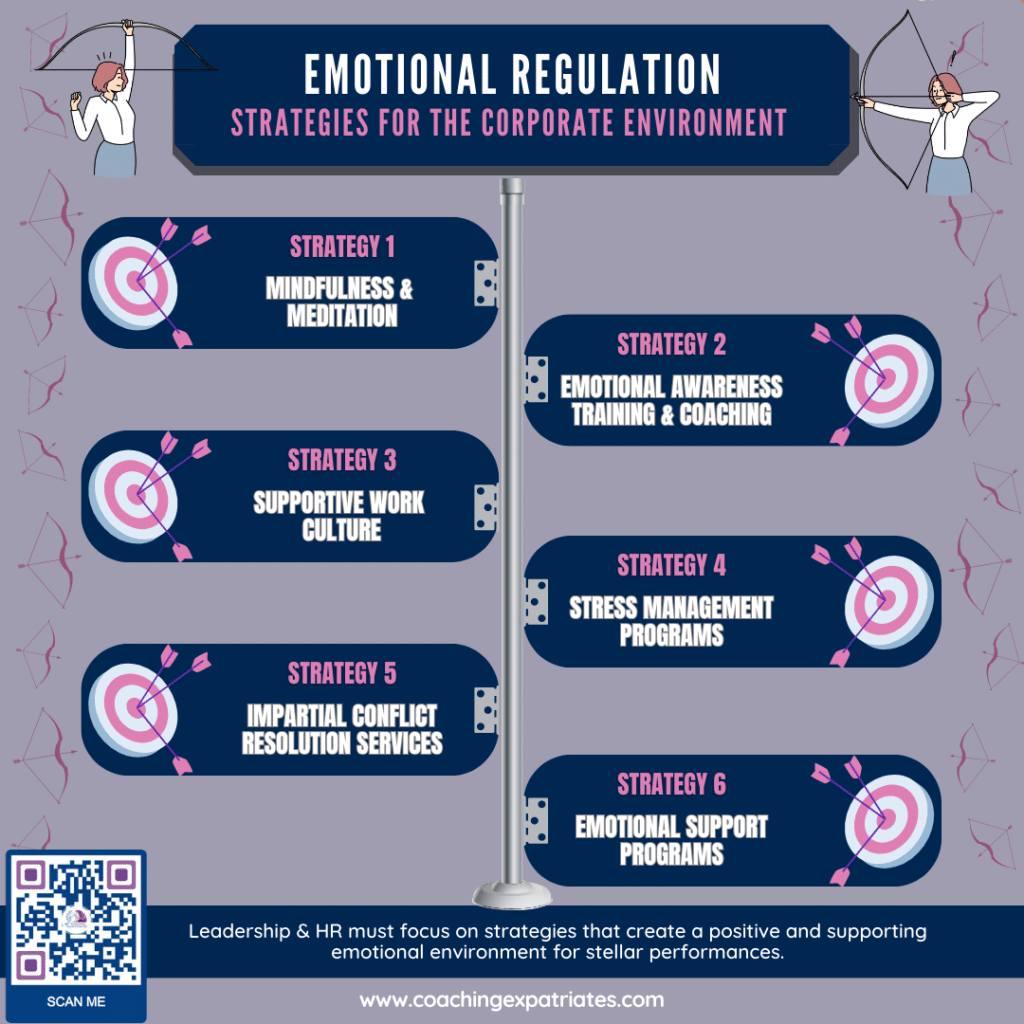
Implementing these strategies requires a collective effort from leaders, managers, and employees to prioritize emotional well-being and create a culture that values emotional regulation. By incorporating these practices, global corporations can foster an environment where employees feel supported, empowered, and capable of regulating their emotions, leading to better decision-making and overall organizational success.
Step-By-Step Process For Emotional Regulation On The Spot
Invariably we find ourselves in difficult situations that provoke and trigger us. When these situations happen, our emotional regulation might be in jeopardy. When that happens, it’s good to have in mind a simple step-by-step process to use while you pause and breathe:
STEP 1: Identify Emotional Triggers And Reduce Them
Start by identifying the situations, people, or events that trigger strong emotional reactions within you. This is not easy to achieve because one must “sit” with the emotions in order to identify them. Reflect on past experiences and patterns to understand what sets off these emotions. Once identified, explore ways to reduce or avoid these triggers whenever possible. For example, if a specific topic of discussion consistently leads to frustration or anger, you can choose to approach the topic in a more measured and objective manner or limit your exposure to it. This is also a technique used in negotiations that are going south: you back off momentarily and resume conversations when the parties are in a better emotional state.
It’s important to clarify what emotional triggers are before we proceed to the next step. According to Dr. Cassio Campello de Menezes, “An emotional trigger is anything from memories to events that can raise an extreme emotional reaction. They usually cause discomfort and can be related to feelings such as rejection, helplessness, unjust treatment, being ignored, or feeling unwanted. Therefore, it is essential to acknowledge them to avoid any undesirable response. When you identify one of those triggers, you can use some skills to help deal with the moment and regain your emotional control.”

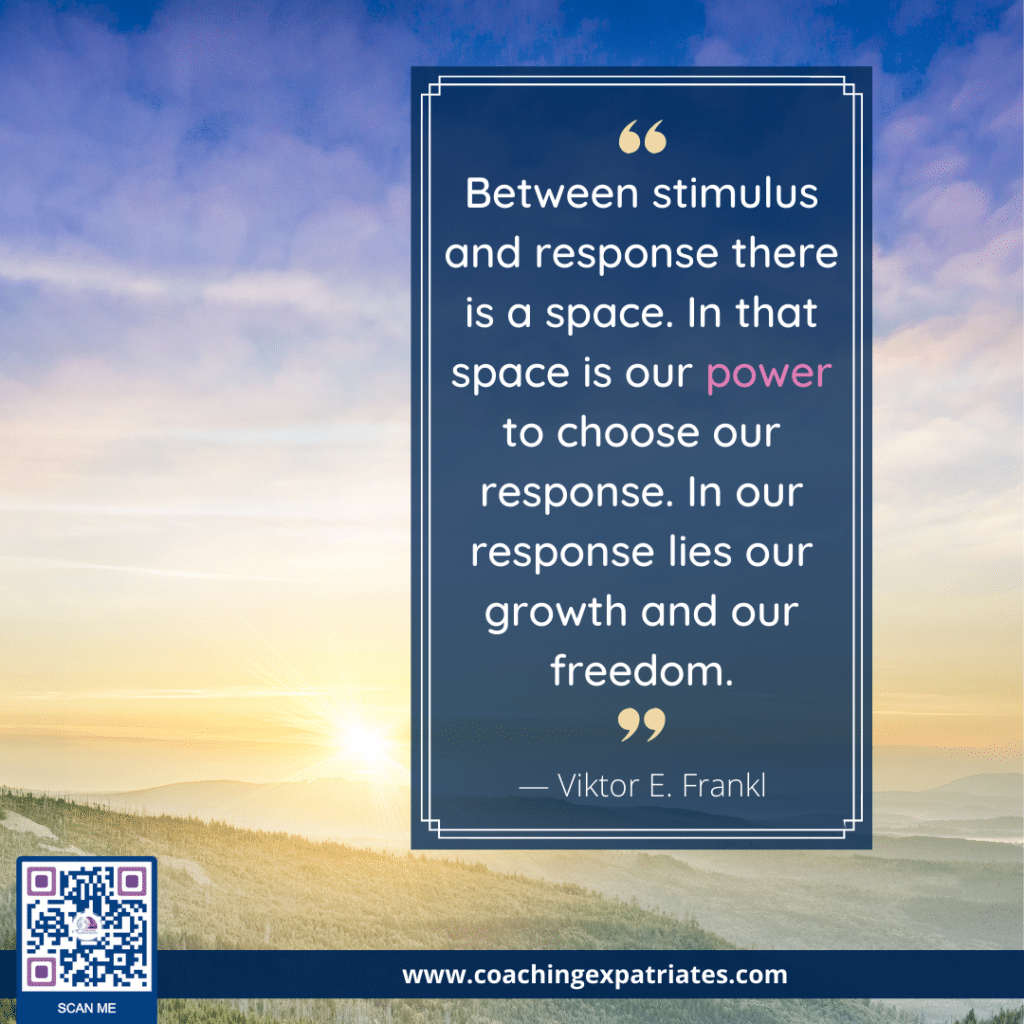
According to Dr. Cassio, being mindful of our feelings is extremely important in this step to properly identify them. Once the feelings were properly identified by “labeling” them, for example, “I’m very angry right now,” he recommends acknowledging them instead of denying them. Studies also show that using the third person to make these acknowledgments can be quite powerful when making emotional decisions and reasoning to regain control or explore feelings.
STEP 2: Define How These Emotions Are Impacting Your Body
Many studies support that emotions can have a physiological effect. In other words, emotions can manifest physically, affecting your body and overall well-being. Pay attention to the physical sensations associated with your emotions, such as increased heart rate, tense muscles or neck, or shallow breathing. By recognizing these bodily responses, you can gain insight into the intensity of your emotions and their impact on your well-being. Engaging in relaxation techniques, such as deep breathing or progressive muscle relaxation, can help calm the physical symptoms associated with intense emotions, which in turn will help you better manage emotional regulation. One skill that can help identify our emotions is “being curious.” According to Dr. Cassio, being curious and trying to define why we were triggered can be very helpful in the process.
STEP 3: Listen To the Story You Are Telling Yourself While Having These Emotions
Our emotions are often influenced by the thoughts and narratives we create in our minds. Take a moment to listen to the story you are telling yourself about the situation or event that triggered the emotions. Are your thoughts grounded in reality or skewed by personal biases or dangerous assumptions? Ask yourself reflective and powerful questions to help you unearth these assumptions. Becoming aware of the narratives allows us to challenge negative or unhelpful thoughts and reframe them in a more balanced and constructive manner. For example, if your boss tells you that they have chosen another person to spearhead a project that you were expecting to be the leader, you might create a story in your head that he is not satisfied with you and will soon fire you. This story might be completely false, and you were actually not chosen because you are about to be promoted and transitioned to somewhere else. Stories in our heads can impact our world and drive our emotions unproductively. Understanding what these stories are can provide greater nuances to our emotions.
STEP 4: Turn The Tables And Engage In Positive Self-Talk
Negative self-talk can intensify and prolong emotional distress. Engaging in negative self-talk is a habit. Counteract this bad habit by consciously engaging in positive self-talk. Challenge any self-critical or negative beliefs and replace them with affirming and encouraging statements. If that’s too difficult for you at first, hire an executive coach to help you turn the tables. For example, if you make a mistake at work and feel a wave of guilt, your coach can help you remind yourself that mistakes are opportunities for growth and learning, and that you are capable of rectifying the situation on top of learning from it. With practice, you’ll quickly learn how to identify negative self-talk on the spot and turn the tables to change the narrative in your head without the support of a professional coach.
STEP 5: Ponder How To Respond, Not React
Emotional regulation involves responding to situations rather than reacting impulsively. Take a step back and consider the best course of action based on your values, long-term goals, and the information available. This actually means “Pause” even if you have to cut a conversation short to recollect yourself. During the “break,” it’s helpful to include in your ponderation what might be going through the other person’s mind and heart. In other words, empathy plays a big role in creating the optimal response. According to Dr. Cassio, this “pause” is a technique called “Time Out,” and he recommends using it to avoid becoming overwhelmed by the feelings and the situation. He also recommends using breathing techniques or grounding exercises to bounce back and be able to create a response quickly. Responding involves a thoughtful and rational approach, considering your actions and words’ consequences and potential impact. You regain control over your emotions and decision-making process by consciously choosing your response. Dr. Cassio recommends always being open-minded, accepting and understanding of our situations, and being assertive in clearly and respectfully communicating our responses using “I statements.” For example, it’s better to say, “I feel frustrated when you talk to me like this.” than “You always make me so mad!” I also want to point out that “pondering how to respond” also means taking the time to make any and all the necessary plans at a detailed level to tackle a situation, which in turn will help you deal with the emotions as well and be prepared for a proper response.
STEP 6: Seek Help If Things Get Out Of Hand
If you find it challenging to regulate your emotions on your own or if they consistently interfere with your well-being and functioning, don’t hesitate to seek support. Reach out to trusted friends, family members, or colleagues who can provide a listening ear, offer guidance, or help you gain a different perspective. Professional help, such as therapy or counseling, can also be beneficial in working on emotional regulation disorders that negatively impact your life at a functional level.
We asked Dr. Cassio the pounding question about when is the right time to seek a Therapist. He said, “Most people seek therapy when they feel stuck in life when they stop the emotional maturation process. You can realize that when you struggle with relationships or stop growing professionally. However, it would be better if you could seek help earlier. As a defense mechanism, we tend to ward off any conflict that brings us frustration or discomfort. Nevertheless, there are times when we cannot do it anymore, causing us many symptoms such as anxiety or depression. A mental health therapist can create a comfortable and contained environment where you can safely talk and discharge all your internal conflicts without judgment. You will be able to release the emotional pressure, giving you more clarity about what is going on with your life. In the long term, it helps to achieve maturational growth and better emotional well-being.”
STEP 7: Consider Hiring A Coach To Develop Emotional Regulation Over Time Before It's Too Late
Working with a life coach specializing in emotional regulation can provide valuable guidance and support. A coach can help you identify your unique emotional patterns, develop personalized strategies, and hold you accountable as you make progress. They can offer techniques, exercises, attitudinal assessments, and insights to enhance your emotional regulation skills and provide ongoing guidance as you navigate challenging situations. A professional coach is different from a Therapist because individuals undergoing therapy are usually not functional anymore in life or at work due to the lack of emotional regulation, while individuals working with coaches want to prevent becoming dysfunctional or want to improve their well-being. If you notice having emotional regulation challenges only at work, working with an executive coach can be beneficial in dissecting the main situations when they happen, understanding triggers that happen at work, and practicing new responses to those situations, which will lower stress levels and anxiety while increasing confidence at the same time. In turn, this can improve your relationships at work, as well as your perceived executive presence as a leader.
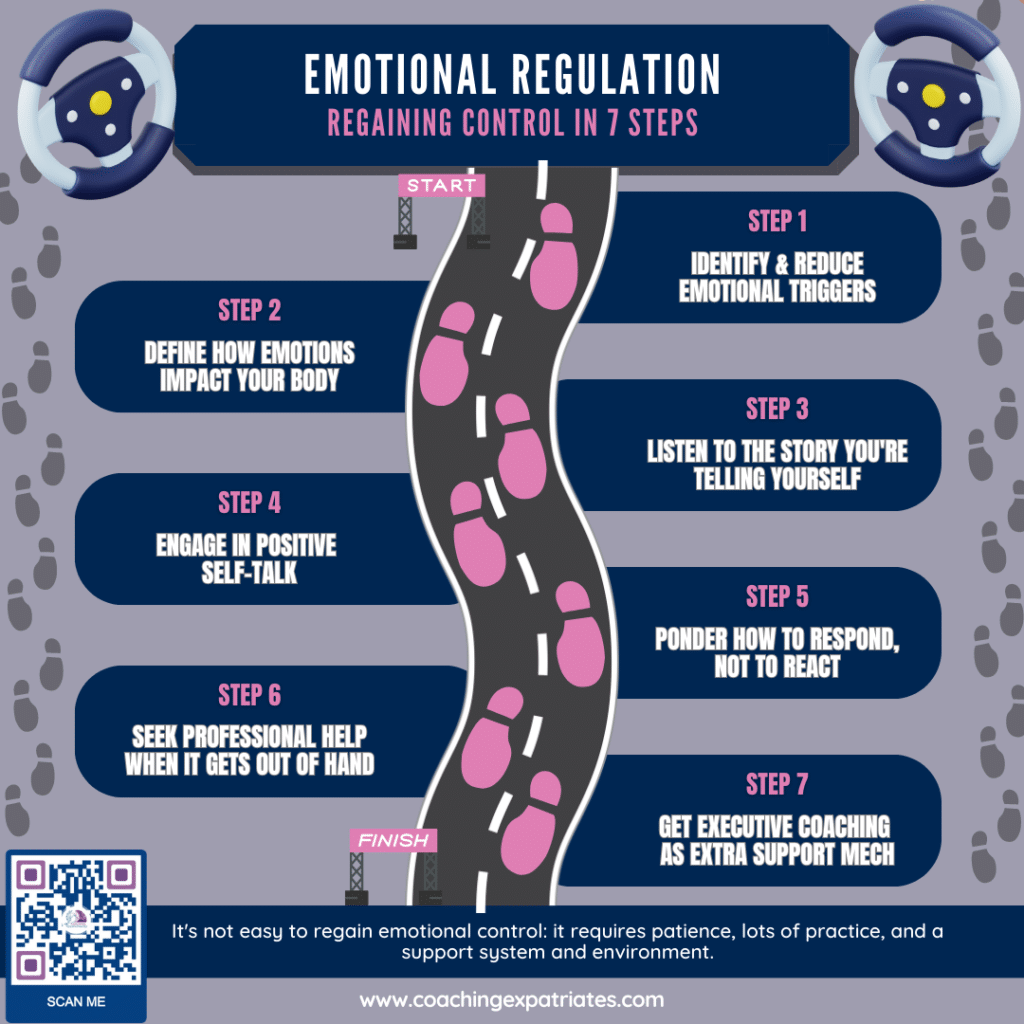
So, as you can see, emotional regulation is a set of skills that take practice and patience to develop and improve. Following these steps and consistently applying the strategies can cultivate a greater sense of emotional balance, enhance decision-making, and improve overall well-being in the corporate environment and beyond.
Skills You Need To Consider Develop For Higher Emotional Regulation
Here are some of the critical skills you need to develop for higher Emotional Regulation. These skills and mindsets are helpful both when regulating emotions at work and at home.
1. Attention-Shifting Strategies: Attention-shifting strategies involve consciously redirecting your focus from distressing or negative thoughts and emotions to more positive or neutral ones. This skill allows you to regain control over your emotional state and prevent rumination or fixation on distressing experiences. Examples of attention-shifting strategies include engaging in distracting activities, practicing visualization techniques, or focusing on a specific task or goal.
2. Mindfulness: Mindfulness is the practice of being fully present and non-judgmentally aware of your thoughts, emotions, and bodily sensations in the present moment. Cultivating mindfulness helps you develop self-awareness and acceptance of your emotions, allowing you to regulate them more effectively. Mindfulness techniques, such as deep breathing exercises, body scans, or mindful meditation, can be incorporated into your daily routine to enhance emotional regulation. For example, I have a mindfulness routine before going to sleep which also helps me wine down and relax before bed. You can introduce a mindfulness routine at a time that works best for you. Early birds often prefer doing it first thing in the morning, some people prefer to do it during lunch break, and others, like me, prefer to engage in mindfulness before bed. Experiment and see what works best for you.
3. Positive Self-Talk: Positive self-talk involves consciously challenging negative or self-critical thoughts and replacing them with positive, affirming, and realistic statements. It seems easy, but it’s not, especially because sometimes we don’t even realize we are engaged in negative self-talk in our minds. By shifting our internal dialogue, we can improve our emotional state and build resilience. Practice recognizing negative self-talk patterns and actively replacing them with positive and constructive self-affirmations. For example, if you make a mistake, instead of berating yourself with harsh criticism and phrases like “Of course! I really suck” or “I’m so darn stupid!” remind yourself that mistakes are opportunities for growth and learning. I’m recently creating a new podcast for global leaders, and after editing an entire long episode, I lost it all after forgetting to save it properly. I was so very frustrated; you can’t even imagine! However, instead of self-criticizing for my poor skills in doing something so simple as to “save my work,” I told myself instead that it happened because the next time I did it, it would become twice as better. Not my surprise, when I edited again — this time properly saving it — it indeed became so much better than the first, lost version. Positive self-talk needs practice!
4. Growth Mindset: A growth mindset is the belief that abilities and intelligence can be developed through dedication, effort, and learning. Adopting a growth mindset helps you view challenges and setbacks as opportunities for growth rather than as personal failures. This growth mindset is part of the success anatomy of any endeavor. Embracing a growth & success mindset allows you to approach emotional regulation as a skill that can be developed and improved over time. It encourages perseverance, resilience, and a willingness to learn from both successes and failures.
5. Celebrating Success: Celebrating success, no matter how small, is an important aspect of emotional regulation. Acknowledging and appreciating your achievements boosts self-confidence, reinforces positive behaviors and self-talk, and provides motivation to continue practicing emotional regulation. Take time to reflect on your progress, set realistic goals, and reward yourself for milestones achieved along the way. Celebrating success cultivates a positive mindset and fosters a sense of fulfillment and accomplishment.
Incorporating these skills into your daily life and consistently practicing them can significantly enhance your emotional regulation abilities. It may require patience, persistence, and self-reflection, but the effort is well worth the rewards. Developing these skills equips you with the tools to navigate challenging situations, regulate your emotions effectively, and lead a more balanced and fulfilling life. Start by focusing and developing one skill at a time and track your progress in terms of emotional regulation performance.
Main Emotional Regulation Disorders You Should Know And How They Can Show Up In Corporate Environments
Emotional regulation disorder, also known as emotion dysregulation or emotional dysregulation, refers to difficulties in managing and controlling one’s emotions effectively. It is characterized by intense, prolonged, or unpredictable emotional responses that are disproportionate to the situation at hand. People with emotional regulation disorders often struggle to regulate their emotions in a way that allows them to function adaptively in various aspects of life.
There are several specific disorders associated with emotional regulation difficulties. Here are some of the most common examples:
1. Borderline Personality Disorder (BPD):
BPD is a mental health disorder characterized by instability in emotions, self-image, and interpersonal relationships. Individuals with BPD often experience intense and rapidly shifting emotions, including anger, sadness, anxiety, and feelings of emptiness. They may have difficulty managing these emotions and exhibit impulsive behaviors, self-destructive tendencies, and a fear of abandonment.
What to watch out for:
- Difficulty building and maintaining healthy relationships: Individuals with BPD may struggle with intense and unstable relationships, characterized by idealization and devaluation. They might have a pattern of quickly forming deep attachments but becoming overly critical or rejecting when their emotional needs are not met.
- Self-destructive behavior: Engaging in self-harm, substance abuse, reckless behaviors (such as impulsive spending or unsafe sex), or suicidal gestures are common in individuals with BPD.
- Frequent meltdowns or temper tantrums: Emotional dysregulation in BPD can lead to emotional outbursts, often in response to perceived abandonment or rejection, even in situations where others may perceive the triggers as minor.
2. Oppositional Defiant Disorder (ODD):
ODD is typically diagnosed in childhood and is characterized by persistent patterns of angry, defiant, and hostile behavior toward authority figures. Individuals with ODD often struggle with emotional regulation, frequently displaying temper tantrums, argumentativeness, and a tendency to blame others for their actions. They may have difficulty coping with frustration or managing their anger appropriately. Leaders with this type of disorder can cause havoc in entire departments or organizations.
What to watch out for:
- Outbursts of emotions that are displaced onto someone who did not cause the harm: leaders with ODD may display intense anger and defiance towards authority figures or peers, overtly or covertly, sometimes projecting their frustrations onto individuals who are not directly involved in the triggering event, especially on employees under them or employees with low position, power, and perceived influence.
- Argumentativeness and defiance: Consistently arguing, challenging rules, and deliberately annoying others are common behaviors associated with ODD.
3. Attention Deficit Hyperactivity Disorder (ADHD):
While primarily known for symptoms related to attention and hyperactivity, individuals with ADHD may also experience emotional regulation difficulties. They may have heightened emotional reactivity, impulsivity, and difficulty modulating their emotional responses. Emotional outbursts, mood swings, and frustration tolerance issues are commonly seen in individuals with ADHD.
What to watch out for:
- Impulsivity: Individuals with ADHD may struggle with impulse control, leading to impulsive decisions, blurting out inappropriate comments, or engaging in risky behaviors without fully considering the consequences.
- Emotional hypersensitivity: People with ADHD can have heightened emotional reactivity, experiencing strong emotional responses to relatively minor events or stimuli that others may perceive as insignificant.
4. Mood Disorders (Depression and Bipolar Disorder):
Mood disorders such as depression and bipolar disorder can impact emotional regulation. In depression, individuals may struggle with regulating feelings of sadness, hopelessness, and low self-esteem. On the other hand, bipolar disorder involves periods of extreme highs (mania) and lows (depression), during which emotional regulation can become challenging, leading to impulsive or erratic behavior.
What to watch out for:
- Persistent sadness or hopelessness: Individuals with depression may experience a pervasive sense of sadness, lack of interest, and hopelessness that affects their ability to regulate emotions and find enjoyment in daily activities. If you think a coworker or even a boss is displaying this type of behavior, have an honest conversation with them to see if they need professional help. If you don’t have their trust or respect to go that far, report to your organization’s appropriate channels if you think that person is putting themselves or others in danger. Make sure this doesn’t become a gossip topic. Your purpose is to help, not to create further drama.
- Manic episodes: In bipolar disorder, individuals may go through periods of elevated mood or mania, characterized by heightened energy, euphoria, impulsive behavior, and increased irritability if their desires are not fulfilled. Leaders with Bipolar disorder often have high turnover rates within their teams and have frequent swings between tremendously high and terribly awful performances.
5. Anxiety Disorders:
Various anxiety disorders, such as generalized anxiety disorder, social anxiety disorder, and panic disorder, can contribute to difficulties in emotional regulation. Anxiety can cause intense fear, worry, and physiological arousal, making it harder to control emotional responses. Individuals may experience frequent emotional distress, heightened irritability, and difficulty calming themselves down after a perceived potential threat.
Dr. Cassio states, “From a psychoanalytical perspective, anxiety can be considered the symptomatic expression of the inner emotional conflict caused when a person suppresses (from conscious awareness) experiences, feelings, or impulses that are too threatening or disturbing to live with. Behavioral psychologists view anxiety as a learned response to frightening events in real life. It can be presented through symptoms such as insomnia, fatigue, aggressiveness, or irritability. Anxiety may happen at any moment in our lifespan. The main difference is that anxiety is expressed in a non-verbal way during childhood. Therefore, its resolution may not occur, leaving “scars” in the mind. Those scars will be responsible for the emotional struggles one may face in adulthood, which can evolve into a mental disorder if it is not addressed.”
What to watch out for:
- Hypersensitivity and exaggerated response to perceived threats: Individuals with anxiety disorders may have heightened sensitivity to potential threats or dangers, leading to intense fear, worry, and emotional reactivity in situations that others may perceive as relatively safe.
- Frequent worry and rumination: People with anxiety disorders often experience persistent and intrusive thoughts related to potential negative outcomes or catastrophic events. In a corporate environment, this looks like an employee or leader who always has a very gloomy perspective, or negative bias, about efforts and outcomes, with a very negative, fearful, and unproductive narrative.
It is important to remember that these examples are not exhaustive, and the manifestations of emotional regulation disorders can vary among individuals. This article is not meant for diagnosis, treatment, recommendations, and advice: seeking professional help from certified mental health practitioners is crucial for accurate diagnosis, personalized treatment, and support in managing these challenges effectively.
Use what you are learning here as a first step to take action to improve your environment or what you are feeling and its impacts on your life.
Best Books On Emotional Regulation
Here are a few books you can get to dive deeper into this topic and become more knowledgeable:
This comprehensive handbook brings together contributions from leading experts in the field of emotion regulation. It covers various aspects of emotion regulation, including cognitive, behavioral, and neural processes. The book explores strategies for understanding and managing emotions in different contexts, such as relationships, work, and health. It provides a wealth of research-based knowledge and practical insights to enhance emotional regulation skills. The “Handbook of Emotion Regulation” is widely regarded as a seminal resource for professionals and researchers in the field.
This detailed workbook is based on Dialectical Behavior Therapy (DBT) and offers practical strategies and exercises for developing emotional regulation skills. It covers mindfulness, distress tolerance, emotion regulation, and interpersonal effectiveness. The book provides step-by-step guidance and is widely acclaimed as an effective resource for individuals seeking to enhance their emotional well-being.
In a groundbreaking book on Emotional Intelligence (EI), Goleman explores the significance of EI in personal and professional success. The book delves into the five key components of emotional intelligence: self-awareness, self-regulation, motivation, empathy, and social skills. It offers insights, case studies, and practical advice for developing emotional regulation abilities. “Emotional Intelligence” became a bestseller, sparking a global conversation about the importance of emotional intelligence in various domains of life. This book can be mind-blowing, and you won’t regret picking it as your next choice of book read.
In this influential book, Bessel van der Kolk, a renowned trauma expert, explores the connection between trauma and emotional regulation. Drawing on his vast clinical experience, he examines how trauma affects the brain, emotions, and physical body. The book provides insights into trauma healing methods and offers practical strategies for cultivating emotional regulation in the context of trauma recovery. “The Body Keeps the Score” has received widespread acclaim and is considered a seminal work in the field of trauma psychology.
This book is not for everyone. You must be really ready and willing to do the hard work of accepting if you want to read it through. Tara Brach, a leading mindfulness teacher and psychologist, presents a compassionate and transformative approach to emotional regulation through radical acceptance. The book explores the power of mindfulness and self-compassion in embracing life’s difficulties, healing emotional wounds, and developing emotional resilience. Brach offers practical techniques and guided meditations to cultivate emotional regulation and foster self-acceptance. “Radical Acceptance” has gained popularity for its accessible and insightful teachings.
In this quite thought-provoking book, psychologist Kelly McGonigal challenges conventional notions about stress and its impact on emotional regulation. She explores research demonstrating that stress can have positive effects and provides strategies for harnessing stress to improve emotional well-being. The book offers practical tools, exercises, and scientific insights to help readers reframe their relationship with stress and develop resilience. “The Upside of Stress” became a bestseller, offering a fresh perspective on stress management and emotional regulation. If you are looking for a book to help you shake your world, this could be it.
Note: While these books have been widely recognized for their valuable insights and impact, it’s important to approach them as complementary resources to professional support and individual needs. The publication years mentioned indicate the initial release of the books, and some have received awards or achieved bestseller status over the years, reflecting their influence and popularity within the field of emotional regulation and related topics.
Final Remarks
Emotional regulation is a fundamental skill that empowers individuals to effectively manage their emotions, make sound decisions, and maintain overall well-being. It involves recognizing, understanding, and modulating one’s emotions in a way that aligns with personal values and long-term goals. By harnessing emotional regulation, we can navigate the complexities of life with greater resilience, empathy, and self-awareness.
Improving emotional regulation requires dedication and practice. Engaging in attention-shifting strategies, embracing mindfulness, utilizing positive self-talk, adopting a growth mindset, and celebrating successes are key skills to develop. These skills empower individuals in the corporate world to redirect their focus, cultivate self-awareness, challenge negative thinking patterns, foster resilience, and nurture a positive mindset.
It’s important to note that emotional regulation is a lifelong journey that requires patience, self-compassion, and continuous growth. It is not about suppressing or denying emotions but rather about developing the ability to navigate them with intention and wisdom. By cultivating emotional regulation, we can experience greater emotional well-being, build healthier relationships, and make more thoughtful decisions.
If you are looking for a leadership development partner and consultant to help you develop some of the skills mentioned in this blog post, you can hire me as your executive and development coach. Have a Free Strategy Call with me. We will go over your challenges and devise together the top actions to implement, with your goals and objectives in mind.
If you are interested in developing specific global leadership skills on top of emotional regulation, check out our online Global Executive Leadership Program. We go over all The Global Leadership Pillars™ during 9 online modules, specially meant for global leadership development. It’s a unique leadership training methodology that will change the way you think, relate, and strategize as a global leader.
If you enjoyed this post, consider subscribing to our newsletter using the form below. We focus on providing excellent bite-sized content to global leaders and executives who want to make strategic business decisions and be more inclusive and influential. We know your inbox is sacred, so we email just once per week, and we never sell, rent or do anything funky with your information. Trust is the basis of Global Leadership, and we fully honor it.
CONTRIBUTIONS
Dr. Cassio Campello de Menezes, MD, MAMHC, LAC, reviewed this post’s technical, psychological content. You can seek psychological assistance from him if you feel your emotional regulation might be dangerously compromising your work, relationships, and life.

Dr. Cassio Campello de Menezes, MD, MAMHC, is a Licensed Associate Counselor and Psychoanalyst Candidate since 2022. He practices at North Jersey Consultation Center (NJCC), an Academy of Clinical and Applied Psychoanalysis (ACAP) clinic offering low-fee psychotherapy and GenPsych. Additionally, he is an adjunct instructor in the Department of Psychology and Counseling at Caldwell University. With two decades of experience as an anesthesiologist, he worked for 12 years with SMA, the largest private anesthesia group in Sao Paulo, Brazil. Dr. Cassio combines his medical expertise with his passion for mental health, providing premier mental health and substance abuse treatment, specializing in group therapy for kids and adolescents.

